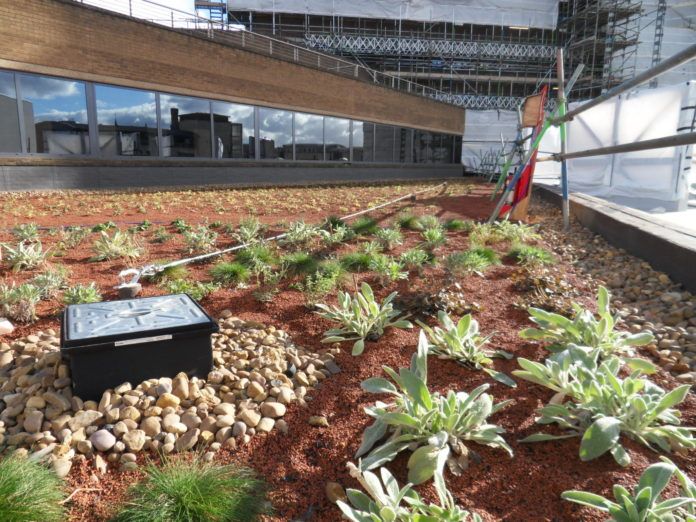As the weather is forecasted to be more erratic over the coming decades, due to temperature rises, Andrew Keer, southern sales manager at ABG, provides an in-depth guide into SuDS drainage systems, which could be the best option as drainage systems that discharge water as quickly as possible become less desirable.
The Met Office projects significant temperature rises in the decades ahead, with extreme weather and flooding events becoming more frequent. Summer rain is forecast to become more intense, leading to a greater risk of flash flooding, and trending wetter winters is also likely to continue, placing greater pressure on existing sewers and flood defences.
As a result, good water management and Sustainable Drainage Systems (SuDS) design practices within new or refurbishment developments are increasingly critical, with traditional rainwater drainage systems that discharge water from buildings as quickly as possible no longer desirable.
Implementing a blue roof provides an important technique to meet SuDS planning application conditions, based on their contribution to reducing the risk of flooding and pollution, and their positive impact on the local landscape and wildlife ecosystems, especially when combined with a green roof or biodiverse finish.
System configuration
Blue roofs introduce drainage voids and restrictor chambers/orifices within the roof build-up to attenuate and release water at a maximum controlled rate. Under normal rainfall events (i.e., most of the year), the roof will continually drain like a normal flat roof.
The blue roof storm water management system only comes into effect during a heavy downpour/key design storm event. At this point, the blue roof will slow the rainwater discharge to the agreed maximum rate to help meet the site’s drainage strategy.
Local rainfall/flood data
As part of the SuDS design process for new planning applications, local flood report data is analysed to model and calculate the attenuation capacity required for the roof during storm events. The rainfall for the specific site is calculated according to location, storm duration and return period (the number of times in a set period that a storm of that magnitude is likely to occur; one in 30 years and one in 100 years storms are usually considered).
In the UK, values are taken from either the Flood Studies Report (FSR) or Flood Estimation Handbook (FEH) data, with an allowance made for the impact of future climatic change, typically +40%.
Structural and loading considerations
Early consultation with the project’s structural engineer should be undertaken to consider any additional loading constraints. However, since blue roofs attenuate rainwater across the entire area of the roof at a shallow depth – typically less than 100mm – this only exerts a maximum additional load of 1.0kN/m2 at full capacity. This can also be offset against the roof’s traditional snow loading.
The blue roof components can be designed to accommodate nearly all eventualities/final area use, including landscaped amenity areas, podium decks for emergency fire and HGV vehicles, and large HVAC plant or PV installations.
Water quality
Installing the blue roof system has a positive impact on the quality of the water discharged. Before the water reaches the roof outlet, it passes through several filtration layers that remove particulates and pollutants. Even if the surface finish is not green, the water passes through at least two layers of geotextile filtration. The water is treated to such a degree that it usually reaches the level required in treatment train stage, which is one of the SuDS process, allowing water to be released from the roof directly into the river or sewer systems.
Waterproofing design
The waterproofing membrane/system selection depends on the type of roof construction, but a BBA-certified system (or similar), accredited for use to zero falls is recommended. ABG’s blue roof system is compatible with both warm and inverted roof constructions, and un-insulated podium constructions. As with traditional roof types, the waterproofing should be detailed to standard height above the final floor levels, with the recommended test methods adhered to ensure integrity, and a full structural deflection analysis.
Installation process, access, and maintenance
Blue roof systems should be fitted as part of an approved installer process and supervised by the manufacturer’s installation team, with post installation quality checks and sign off procedures. The system must also have a provision for regular maintenance and therefore future access should be considered to suit the final finish, as with all roofing applications.
Decking areas, paved podium decks and ballasted roofs are relatively low maintenance, whereas green roofs usually require twice yearly maintenance visits to monitor and remove invasive species and trim vegetation.
Thermal performance
Currently, the components of a blue or green roof are not considered as part of the roof build up when calculating thermal performance, so the insulation design and specification is the same as for a traditional roof design. Despite UK building regulations currently making no allowance for a blue or green roof, research shows that the introduction of layers of drainage, growing media and vegetation do have a positive impact on the thermal performance of a roof, with the most significant benefit being a reduction in solar gain.
Blue roofs are rated as one of the most sustainable, ‘at source’ SuDS techniques, and can often meet all four of the objectives for good SuDS design. When implemented correctly, they form an integral source control and attenuation element for modern developments.




